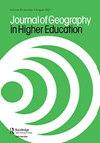Adopting and using geospatial technologies for teaching geography in Latin American higher education
IF 1.8
4区 教育学
Q2 EDUCATION & EDUCATIONAL RESEARCH
引用次数: 0
Abstract
ABSTRACT The article presents the results of a regional study analysing the factors that predict Latin American faculty adoption and use of geospatial technologies (GST) for teaching geography. The research involved an online survey with 337 participants from 17 countries, who answered a set of items adapted from the Unified Theory of Acceptance and Use of Technology on five GST – desktop GIS, web-based GIS, remote sensing, GPS, and digital globes. The data was analysed using a structural equation modelling. The results confirmed that faculty who identified pedagogical benefits of using GST considered technologies as easy to master, and valued the opinion of people influential to them about using technologies were more likely to be motivated to use GST for teaching. In addition, faculty willing to use the GST and report adequate institutional conditions were more likely to be using the technologies for teaching. Additional statistical testing found that human geography faculty expressed an infrequent use of these technologies compared to their physical geography and geospatial technologies colleagues, who did report a more consistent use of GST. These findings suggest a divide among Latin American faculty regarding the motivation and institutional conditions to implement technologies, based on their field of expertise.在拉丁美洲高等教育地理教学中采用和使用地理空间技术
摘要本文介绍了一项区域研究的结果,该研究分析了预测拉丁美洲教师采用和使用地理空间技术(GST)进行地理教学的因素。这项研究涉及一项来自17个国家的337名参与者的在线调查,他们回答了一组改编自《接受和使用技术统一理论》的项目,涉及五个GST——桌面GIS、网络GIS、遥感、GPS和数字地球仪。使用结构方程模型对数据进行了分析。研究结果证实,那些确定使用商品及服务税的教学益处的教师认为技术很容易掌握,并重视对他们有影响力的人对使用技术的意见,他们更有可能被激励使用商品和服务税进行教学。此外,愿意使用商品及服务税并报告适当机构条件的教师更有可能使用这些技术进行教学。额外的统计测试发现,与自然地理和地理空间技术的同事相比,人文地理系教师很少使用这些技术,他们确实报告了商品及服务税的使用更加一致。这些发现表明,拉丁美洲教师在实施技术的动机和制度条件方面存在分歧,这是基于他们的专业领域。
本文章由计算机程序翻译,如有差异,请以英文原文为准。
求助全文
约1分钟内获得全文
求助全文
来源期刊

Journal of Geography in Higher Education
Multiple-
CiteScore
5.80
自引率
9.50%
发文量
29
期刊介绍:
The Journal of Geography in Higher Education ( JGHE) was founded upon the conviction that the development of learning and teaching was vitally important to higher education. It is committed to promote, enhance and share geography learning and teaching in all institutions of higher education throughout the world, and provides a forum for geographers and others, regardless of their specialisms, to discuss common educational interests, to present the results of educational research, and to advocate new ideas.
 求助内容:
求助内容: 应助结果提醒方式:
应助结果提醒方式:


